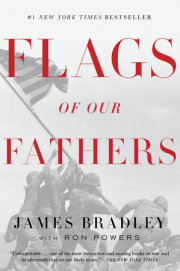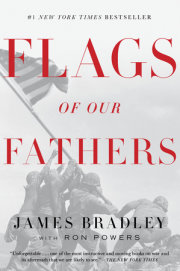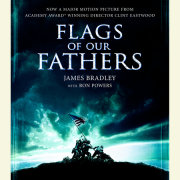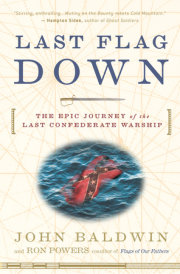Sacred Ground
The only thing new in the world is the history you don't know —Harry Truman
In the spring of 1998 six boys called to me from half a century ago on a distant mountain, and I went there. For a few days I set aside my comfortable life—my business concerns, my life in Rye, New York—and made a pilgrimage to the other side of the world, to a tiny Japanese island in the Pacific Ocean called Iwo Jima.
There, waiting for me, was the mountain the boys had climbed in the midst of a terrible battle half a century earlier. The Japanese called the mountain Suribachi, and on its battle-scarred summit the boys raised an American flag to symbolize our country's conquest of that volcanic island, even though the fighting would rage for another month.
One of those flag raisers was my father.
The fate of the late twentieth and twenty-first centuries was being forged in blood on the island of Iwo Jima and others like it in the Pacific, as well as in North Africa, parts of Asia, and virtually all of Europe. The global conflict known as World War II had mostly teenagers as its soldiers—kids who had come of age in cultures that resembled those of the nineteenth century.
My father and his five comrades—they were either teenagers or in their early twenties—typified these kids: tired, scared, determined, brave. Like hundreds of thousands of other young men from many countries, they were trying to do their patriotic duty and trying to survive.
But something unusual happened to these six: History turned all its focus, for 1/400th of a second, on them. It froze them in an elegant instant of one of the bloodiest battles of the twentieth century, if not in the history of warfare—froze them in a camera lens as they hoisted an American flag on a makeshift iron pole.
Their collective image became one of the most recognized and most reproduced in the history of photography. It gave them a kind of immortality—a faceless immortality. The flag raising on Iwo Jima became a symbol of the island, the mountain, the battle; of World War II; of the highest ideals of the nation; of valor itself. It became everything except the salvation of the boys who performed it.
For these six, history had a different, special destiny that no one could have predicted, least of all the flag raisers themselves.
My father, John Henry Bradley, returned home to small-town Wisconsin after the war. He shoved the mementos of his immortality into a few cardboard boxes and hid these in a closet. He married his childhood sweetheart. He opened a funeral home, fathered eight children, joined the PTA, the Lions, and the Elks—and shut out virtually any conversation on the topic of raising the flag on Iwo Jima.
When he died, in January 1994, in the town of his birth, he might have believed he was taking the story of his part in the flag raising with him to the grave, where he apparently felt it belonged. He had trained us, as children, to deflect the phone-call requests for media interviews that never diminished over the years. We were to tell the caller that our father was on a fishing trip, usually in Canada. But John Bradley never fished. No copy of the famous photograph hung in our house. When we did manage to extract from him a remark about the incident, his responses were short and simple, and he quickly changed the subject.
And this is how we Bradley children grew up: happily enough, deeply connected to our peaceful, tree-shaded town, but always with a sense of an unsolved mystery somewhere at the edges of the picture.
A middle child among the eight, I found the mystery tantalizing. I knew from an early age that my father had been some sort of hero. My third-grade schoolteacher said so; everybody said so. I hungered to know the heroic part of my dad. But try as I might, I could almost never get him to tell me about it.
John Bradley might have succeeded in taking his story to his grave had we not stumbled upon the cardboard boxes a few days after his death.
My mother and brothers Mark and Patrick were searching for my father's will in the apartment he had maintained as his private office. In a dark closet they discovered three heavy cardboard boxes. In those boxes my father had saved the many photos and documents that came his way as a flag raiser. All of us were surprised that he had saved anything at all.
Later I rummaged through the boxes. One letter caught my eye. The cancellation indicated it was mailed from Iwo Jima on February 26, 1945, written by my father to his folks just three days after the flag raising: "I'd give my left arm for a good shower and a clean shave, I have a 6 day beard. Haven't had any soap or water since I hit the beach. I never knew I could go without food, water or sleep for three days but I know now, it can be done."
And then, almost as an aside, he wrote: "You know all about our battle out here. I was with the victorious [Company E,] who reached the top of Mt. Suribachi first. I had a little to do with raising the American flag and it was the happiest moment of my life."
The "happiest moment" of his life? What a shock! If it made him so happy, why didn't he ever talk about it? Did something happen either on Iwo Jima or in the intervening years to cause his silence?
Over the next few weeks I found myself staring at the photo on my office wall, daydreaming. Who were those boys with their hands on that pole? Were they like my father? Had they known one another before that moment or were they strangers united by a common duty? Was the flag raising the "happiest moment" of each of their lives?
The quest to answer those questions consumed four years of my life and ended, symbolically, with my own pilgrimage to Iwo Jima.
Iwo Jima is a very small place to have hosted such a savage battle. Only eight square miles, the tiny island barely crests the seemingly infinite Pacific. The value of capturing this speck of land for the Americans was its location and its two airfields. The island provided a place for American planes to stop and refuel on crucial bombing missions to and from Japan.
Not many Americans make it to Iwo Jima these days. It is a dry wasteland of black volcanic ash that reeks of sulfur (the name means "sulfur island"). A closed Japanese naval base, it is inaccessible to civilians except for rare government-sanctioned visits.
It was the commandant of the Marine Corps, General Charles Krulak, who made the trip possible for me, my seventy-four-year-old mother, three of my brothers—Steve, Mark, and Joe—and many military men and women. One of first things we did on the island was to walk across the beach closest to Mount Suribachi, on the black volcanic sands. On their invasion maps the Marines had dubbed it "Green Beach," and it was across this killing field that young John Bradley, a Navy corpsman, raced under heavy fire. I watched as my mother made her way across that same beach, sinking to her ankles in the soft volcanic sand with each step. "I don't know how anyone survived!" she exclaimed.
Then it was time for our family to ascend the 550-foot volcanic crater that was Mount Suribachi. My twenty-one-year-old father had made the climb on foot carrying bandages and medical supplies; our party was whisked up in vans. I stood at its summit in a whipping wind that helped dry my tears. This was exactly where that American flag was raised on a February afternoon fifty-three years before. The wind had whipped on that day as well.
From the edge of the extinct volcanic crater, we could view the entire two-mile beach where the armada had discharged its boatloads of Marines. In February 1945 the Japanese could see it with equal clarity from the tunnels just beneath us. They waited patiently until the beach was crowded with American boys. They had spent many months positioning their gun sights. When the time came, they simply opened fire, beginning one of the great military slaughters of all history.
An oddly out-of-place feeling seized me: I was so glad to be there! The vista below us, despite the gory history, was invigorating. The sun and the wind seemed to bring all of us alive. At Suribachi you feel on top of the world, surrounded by ocean.
And then I realized that my high spirits were not so out of place at all. I was reliving something. I recalled the line from the letter my father wrote three days after the flag raising: "It was the happiest moment of my life."
We Bradleys then began to take pictures. We posed in various spots, including near the X that marks the spot of the actual raising. We had brought with us a plaque to personally commemorate the flag raising and our father's role in it. Joe gently placed the plaque in the dry soil.
IN MEMORY OF
JOHN H. BRADLEY
FLAG RAISER
2-23-45
FROM HIS FAMILY
I began to speak to the Marines who had gathered in front of our memorial.
I spoke first of the battle. It ground on over thirty-six days. It claimed 25,851 U.S. casualties, including nearly 7,000 dead. Most of the 22,000 defenders fought to their deaths.
It was America's most heroic battle. Two out of every three Americans who fought on this island were either killed or wounded. More medals for valor were awarded for action on Iwo Jima than in any battle in the history of the United States. To put that into perspective: The Marines were awarded eighty-four Medals of Honor in World War II. Over four years, that was twenty-two a year, about two a month. But in just one month of fighting on this island, they were awarded twenty-seven Medals of Honor, one-third of their accumulated total.
Next I showed the Marines the famous flag-raising photograph. I remarked that nearly everyone in the world recognizes it, but no one knows the boys.
I pointed to the figure in the middle of the image: solid, anchoring, with both hands clamped firmly on the rising pole. That's my father, I said. John Bradley was known to the other Marines in his company as "Doc" because he was a medical corpsman. He is the most identifiable of the six figures, the only one whose profile is visible.
I pointed next to a figure on the far side of John Bradley. Rene Gagnon, the handsome mill hand from New Hampshire, stood shoulder to shoulder with my dad in the photo, but he is mostly obscured by my father.
I gestured to the figure on the far right of the image, the leaning, thrusting soldier jamming the base of the pole into the hard Suribachi ground. His right shoulder is nearly level with his knee. His buttocks strain against his fatigues. This was Harlon Block, the athletic, independent-minded Texan. A star football player, he enlisted in the Marines along with all the seniors on his high school football team.
I pointed to the figure directly in back of my father: the boyish, freckle-faced Franklin Sousley, from Hilltop, Kentucky. He was fatherless at the age of nine and sailed for the Pacific on his nineteenth birthday.
Look closely at Franklin's hands, I asked the silent crowd in front of me. Do you see his right hand? Can you tell that the man in back of him has grasped Franklin's right hand and is helping Franklin push the heavy pole? The most boyish of the flag raisers, I said, is getting help from the most mature, Sergeant Mike Strank.
I pointed now to what can be seen of Mike. He is on the far side of Franklin. You can hardly see him. But his helping young Franklin was typical of him. He was respected as a great leader, a Marine's Marine. Finally I singled out the figure at the far left of the image—the figure stretching upward, his fingertips not quite reaching the pole. The Pima Indian from Arizona. Ira Hayes, I said. His hands couldn't quite grasp the pole.
Six boys. They form a representative picture of America in the thirties and forties: a mill worker from New England, a Kentucky tobacco farmer, a Pennsylvania coal miner's son, a Texan from the oil fields, a boy from Wisconsin's dairy land, and an Indian living on an Arizona reservation.
Only two of them walked off this island. A third was carried on a stretcher with shrapnel embedded in his side. Three were buried here.
Holy Land. Sacred ground.
TWO
All-American Boys
All wars are boyish, and are fought by boys —Herman Melville
I'm not a professional researcher, but I figured that if I could somehow dig deep enough, I might be able to learn something about these six boys, and especially about my silent father. I could not do this task alone. I would need other people, relatives and comrades of these six figures, to help me.
I began my research by buying a book about Iwo Jima and reading it. Then another. And another. I have since lost count.
I found names in those books—the names of the boys shoving that flagpole aloft.
Back in my office, I started to trace them. I phoned city halls and sheriff's offices in the towns where the flag raisers were born and asked for leads that would put me in touch with their relatives. I dialed the numbers, then waited through the rings for that first "Hello?" from a widow, sister, or brother of one of the boys whose hands had gripped the iron pole on Suribachi.
I widened my phone searches to include living veterans of Iwo Jima. I wanted their memories, too. Eventually I began to travel to the places where these people lived.
I wanted to know them as Marines, as fighting men who were also comrades. But I also wanted to know them as boys, ordinary kids before they became warriors.
What I found was that these six boys were very different from one another: the whooping young Texas cowboy; the watchful Indian; the happy-go-lucky Kentucky hillbilly; the serious Wisconsin small-towner; the handsome New Hampshire mill worker; the sturdy Czech immigrant.
And yet so similar.
They were nearly all poor. The Great Depression was a thread that ran through their lives. But then so did football, and religious faith, and strong mothers. So did younger siblings, and the responsibility of caring for them. And nearly all were described again and again as quiet, shy boys, yet boys whom people cared about.
Copyright © 2001 by James Bradley with Ron Powers; Adapted for Young People by Michael French. All rights reserved. No part of this excerpt may be reproduced or reprinted without permission in writing from the publisher.











